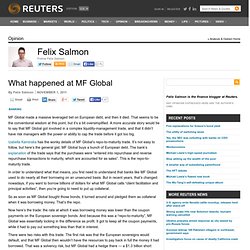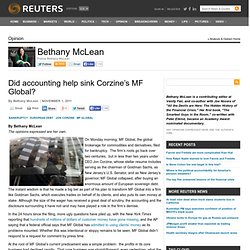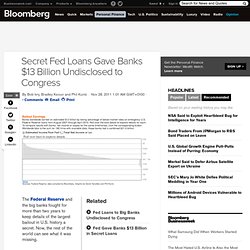

What happened at MF Global. MF Global made a massive leveraged bet on European debt, and then it died.

That seems to be the conventional wisdom at this point, but it’s a bit oversimplified. A more accurate story would be to say that MF Global got involved in a complex liquidity-management trade, and that it didn’t have risk managers with the power or ability to cap the trade before it got too big. Izabella Kaminska has the wonky details of MF Global’s repo-to-maturity trade. It’s not easy to follow, but here’s the general gist. MF Global buys a bunch of European debt. In order to understand what that means, you first need to understand that banks like MF Global used to do nearly all their borrowing on an unsecured basis. So as soon as MF Global bought those bonds, it turned around and pledged them as collateral when it was borrowing money.
Now here’s the trade: the rate at which it was borrowing money was lower than the coupon payments on the European sovereign bonds. There were two risks with this trade. MF Global Accounting Gimmick. By Bethany McLeanThe opinions expressed are her own.

On Monday morning, MF Global, the global brokerage for commodities and derivatives, filed for bankruptcy. The firm’s roots go back over two centuries, but in less than two years under CEO Jon Corzine, whose stellar resume includes serving as the chairman of Goldman Sachs, as New Jersey’s U.S. Senator, and as New Jersey’s governor, MF Global collapsed, after buying an enormous amount of European sovereign debt. The instant wisdom is that he made a big bet as part of his plan to transform MF Global into a firm like Goldman Sachs, which executes trades on behalf of its clients, and also puts its own money at stake. Although the size of the wager has received a great deal of scrutiny, the accounting and the disclosure surrounding it have not–and may have played a role in the firm’s demise. MF Global - Repo to maturity. Credit Crisis 2008. Lehman Brothers & Bear Stearn. Ratings conflict. SEC goes after Goldman. Why investors are suing the banks. Secret Fed Loans Gave Banks $13 Billion.
The Federal Reserve and the big banks fought for more than two years to keep details of the largest bailout in U.S. history a secret.

Now, the rest of the world can see what it was missing. The Fed didn’t tell anyone which banks were in trouble so deep they required a combined $1.2 trillion on Dec. 5, 2008, their single neediest day. Bankers didn’t mention that they took tens of billions of dollars in emergency loans at the same time they were assuring investors their firms were healthy. And no one calculated until now that banks reaped an estimated $13 billion of income by taking advantage of the Fed’s below-market rates, Bloomberg Markets magazine reports in its January issue. Saved by the bailout, bankers lobbied against government regulations, a job made easier by the Fed, which never disclosed the details of the rescue to lawmakers even as Congress doled out more money and debated new rules aimed at preventing the next collapse.
‘Change Their Votes’